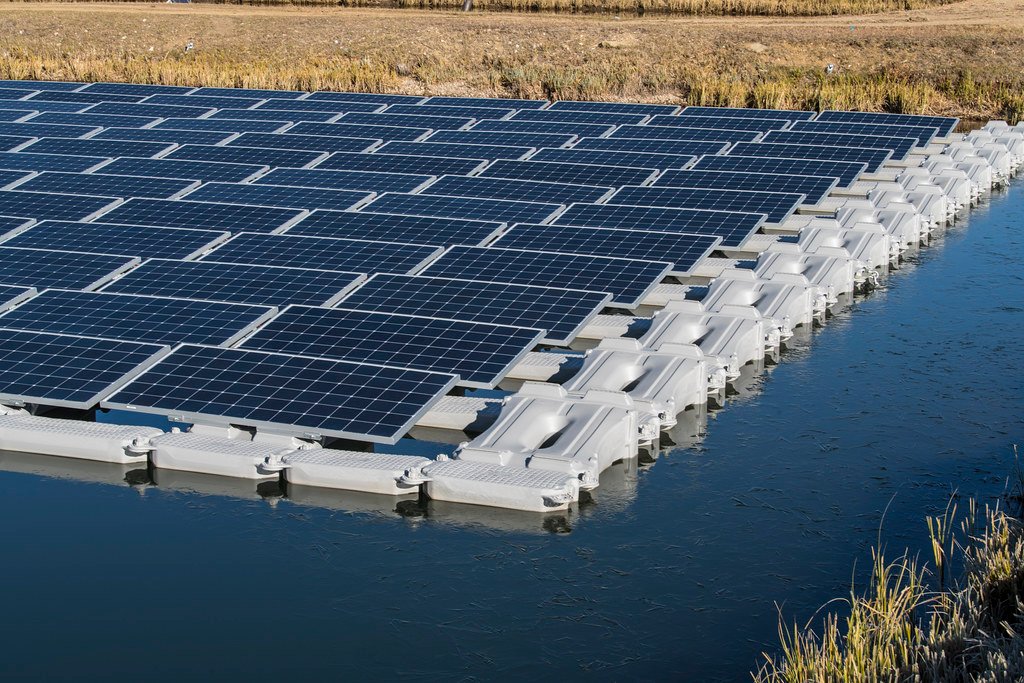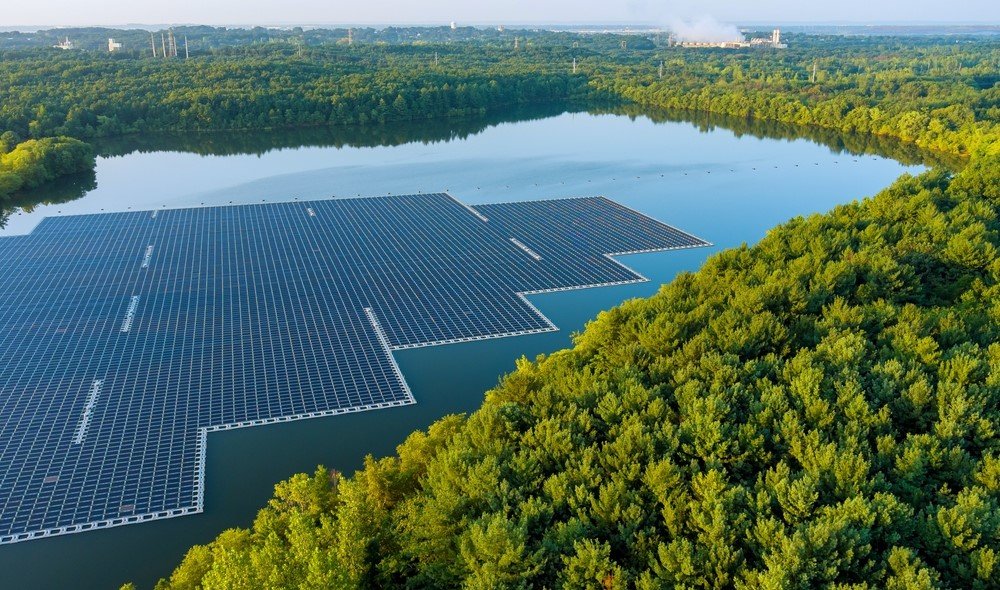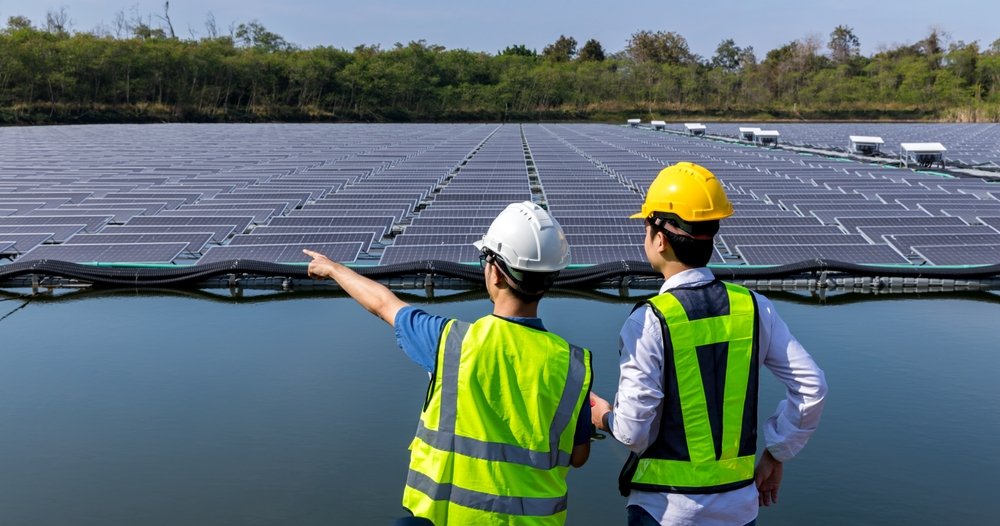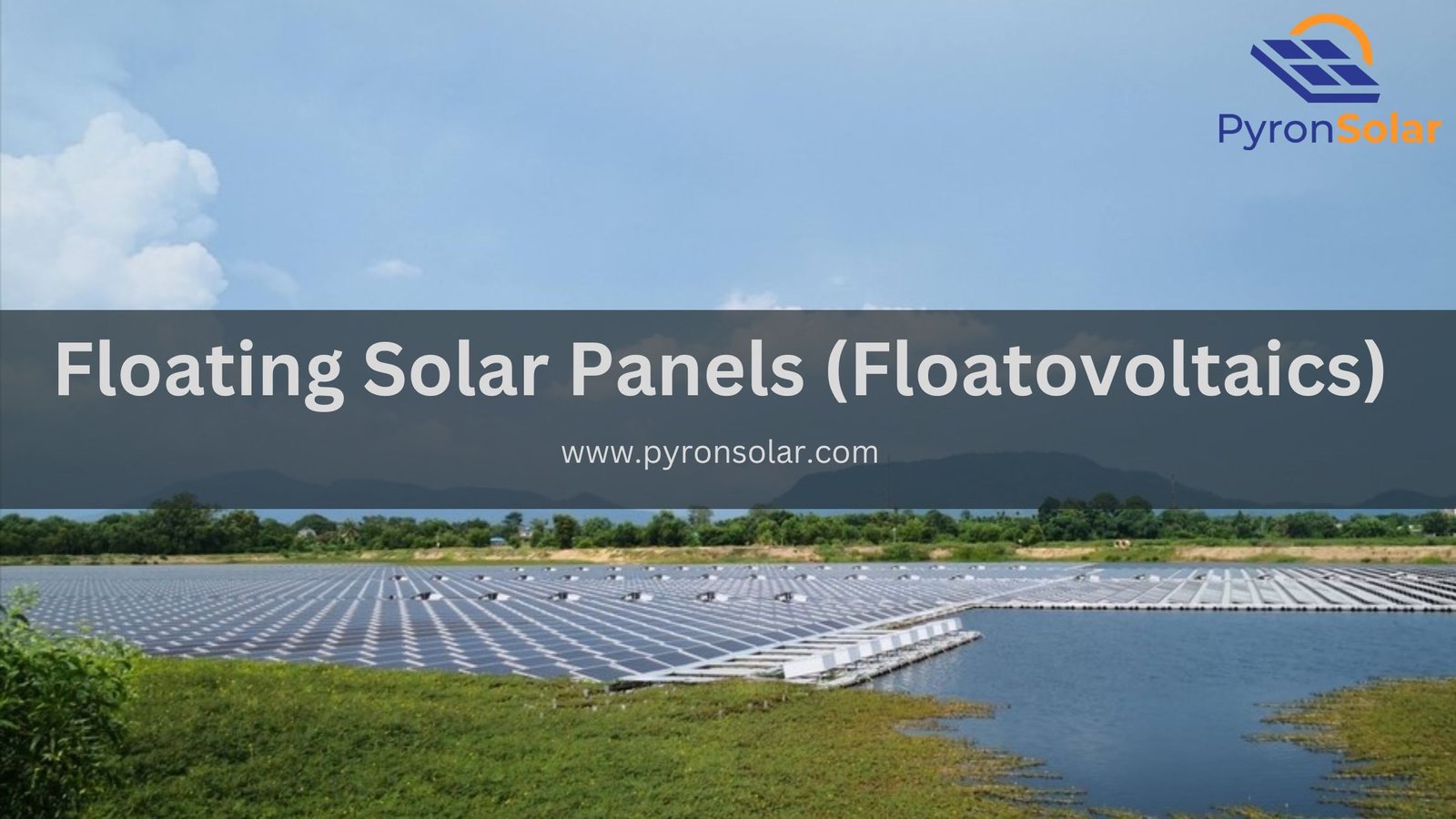Floating solar panels, also called floatovoltaics, are photovoltaic modules mounted on floating platforms on water bodies. It can be either the reservoirs, the lakes, or even the ocean and the seas, depending on the natural conditions. It is also known as floating photovoltaic (FPV).
The major difference between floating and traditional solar panels is how the floating system is installed. Traditional solar panels are attached to roof frames or the ground using racking. Whereas, the floating solar panels are placed on top of water surfaces.
These floating solar systems are generally used on water bodies, including drinking water reservoirs, hydroelectric dam reservoirs, wastewater ponds, quarry lakes, irrigation canals, or remediation and tailing ponds.

Floating solar panels are rapidly gaining popularity in the US and other countries. This is because they are less expensive compared to land-based plants, and they can also save land occupation, with easier installation and dismantling processes.
Before deciding, you must know the working procedure, benefits, drawbacks, various applications, and factors to consider before buying floating solar panels. Also, we will discuss their lifespan and their usage in conjunction with the land-based solar systems.
How Do Floating Solar Panels Work
Floating Solar plants or floating photovoltaic (FPV) systems are solar panels mounted on a buoyant or floating structure that allows them to float on water bodies. Here is a brief overview of the floating solar panel components and how they work:
- PV Modules: These are specific solar cells that directly capture the sun’s energy and transform it into usable electricity.
- Floaters: These are modular plastic floating platforms on which the solar panels are installed.
- Mooring System: These elements hold the solar panels in their floating positions from the depth of the water.
- Combine Box: It collects all the panels’ outputs and sends them to its central inverter.
- Central Inverter: This device transforms the DC power to AC power.
- Transformer: It degrades power for transmission.
- Cabling: These are the nodes that interconnect the solar panels, inverter, combined box and transformer.
- Transmission System: This transmission line travels inland to provide power whenever and wherever it is required.
- Floating Walkways: They offer access from the inland side.
The floating solar panels are operated in the same manner that the traditional land-based panels do, and what they do is generate electricity by capturing sunlight. They possess the advantage of mirror reflecting light from the water surface, which might improve their efficiency.
The water which surrounds the installations can also help in reducing the temperature, which further helps in making the panels more efficient. The power that the solar cells generate goes into the combined box, after which it is transmitted to the central inverter.
The inverter converts the DC power generated by the panels into alternating current (AC) power for transmission. The energy will then be delivered to the transmission tower by underwater cables.
Benefits of Floating Solar Panels

The following are the major advantages and floating solar panels benefits in terms of More Efficiency, Conservation of Valuable Land Space, Water Conservation, Reduction in Algae Bloom, and Combination with Hydropower.
More Efficiency
Temperature increase is one of the causes for reducing the solar panel efficiency. However, the bodies of water that support floating solar units cool down the equipment, which means the solar panels produce electricity at increased efficiency even during hot climates.
Generally, these floating solar panels reportedly tend to have 15% more efficiency compared to land-based solar panels.
Conservation of Valuable Land Space
One of the most essential benefits of floating solar panels is that these installations do not require highly valuable and hard-to-find land space. Instead of installing it on sunny land, these installations offer the benefit to landowners by mounting on the unused space of water bodies.
Water Conservation
Floating solar systems make a huge difference in water conservation efforts. Generally, it shades the water surface and reduces water evaporation, which is especially very beneficial in those regions where water resources are very limited or scarce.
Reduction in Algae Bloom
Floating solar panels help in reducing the algae blooms in freshwater bodies or drinking water sources, which can lead to severe health complications. It can also cause the death of animals and plants in the water.
These floating solar panels use the Shading Effect, Water Cooling, Evaporation Reduction and by altering phytoplankton dynamics.
Combination with Hydropower
Floating solar panels are capable of improving currently operating hydroelectric power facilities by installing solar panels on the same water body. It reduces the evaporation of water on the surface of solar panels and balances during different seasons like monsoons and winters.
However, it can be used to generate hydroelectric power, using the same water bodies for dual-energy production, which maximizes resource usage as a hybrid system (producing both solar and hydroelectric power).
Drawbacks of Floating Solar Panels
You need to analyse the other side of floating solar panels by considering their disadvantages such as High Installation Costs, Increased Maintenance in Aquatic Environments, Impact on Aquatic Life and Site selection complications.
High Installation Cost
The installation cost of floating solar panels typically ranges between $2.50 to $4.50 per watt, which is highly expensive. For a residential installation of 5kW capacity, the solar panels cost between $12,550 and $22,550 approximately. Additionally, to set up a 1MW floating solar panel project output, the cost ranges from $6,30,000 to $7,65,000.
The floating panels have 10% higher efficiency and require additional cost than conventional solar panels.
One of the main reasons why floating solar panels are expensive is because it is logistically more complicated than the land-based versions, which require specialized equipment and in-depth installation knowledge.
Increased Maintenance in Aquatic Environments
Although the cooling effect of water can increase the panel efficiency, the materials used in solar panels are less durable and cannot resist for a long time when exposed to water surfaces and sunlight, thereby making maintenance complicated. As a result, various concerns arise about the potential degradation and release of pollutants over a certain time.
Also, the floating photovoltaic system is a new concept, the cleaning techniques haven’t been extensively researched. Most importantly, the water quality can restrict the application of various cleaning processes. It results in a complicated servicing process and the routine checks, cleanings, and repairs cannot be performed easily.
Various strategies are employed to mitigate the maintenance demands such as occupational safety and health (OSH) to achieve the goals of sustainable development which include reducing physical loads, designing innovative tools, task rotation and several other measures.
Impact on Aquatic Life
The shading effect of large-scale Floating Photovoltaics (FPV) power stations can reduce the concentration of dissolved oxygen supply and light for photosynthesis by aquatic plants will have a severe effect on the ecosystems. FPV results in a more unstable and shorter thermal distribution during summer, which mitigates the effects of climate change and increases the water temperature under panels.
The leaching of heavy meals and boron not only contaminates the water bodies but also depletes soluble oxygen and increases environmental toxicity.
To mitigate the Floatovoltaic’s impact on aquatic ecosystems, numerous strategies like placing floating panels into irrigation channels and hydropower plant reservoirs can help to distribute energy evenly. Additional methods to mitigate these impacts include using environmentally friendly materials to reduce water contamination and selecting locations that are less prone to shading.
Site Selection Complications
In areas with huge lake coverage, the FPV can result in more unstable and shorter thermal storage during summer, which can pose issues on the structural integrity of the floating solar system.
Also, the deeper water bodies impact the deployment of floating solar panels as more powerful and costly support systems are required
Poor water quality leads to the accumulation of dirt and other substances on solar panels that can reduce durability and efficiency.
Considering regulations like water and land usage, environmental impact and electrical connections limits the deployment of floating solar panels.
{Video Credit- ANC 24/7}
Applications of Floating Solar Panels

Floating solar panels can be installed on any type of water surface where there is less competition for usage such as salt and fresh waters, reservoirs, hydroelectric dams, lakes and several others. You can also install it on oceans and seas depending upon the condition to withstand saltwater and waves.
Let us consider some examples globally ( including the US) to prove the successful application of floating panel technology:
- Netherlands: In the southwest Netherlands, Oostvoornse Meer— a lake located on the island of Voorne, is covered with 180 moving solar panels installed with a total capacity of 73 kW of maximum power.
- Spain: The floating solar farm in Seville, Spain is built on a saltwater body of water with a capacity of 1.2 MW. The electricity is generated by Concentrated Solar Power (CSP) technology, combined with floating solar panels and molten salt storage.
- South Korea: The largest floating solar energy farm at Saemangeum, South Korea has the highest capacity of 2.1GW.
- Japan: The floating solar panel on Yamakura Dam in Japan has a capacity of 13.7MW, and it is the largest solar installation in the world that efficiently uses the dam’s water surface to generate solar energy.
- US: Floating solar panels are instantly gaining in the US, particularly in California and New Jersey.
According to the NREL, The Cohoes — a municipal reservoir in New York, will become the first city-owned-and-operated floating solar installation in the nation. However, the first public floating solar installation in the US was done by Ciel & Terre and the structure comprised 720 solar panels and floats on an artificial wastewater treatment water body. Later, this system was financed through a municipal lease by the Lake County Special District.
Factors to Consider Before Buying Floating Solar Panels
As a potential buyer, you should consider these factors before investing in floating solar panels:
1. Site Suitability: Evaluate various factors of the site such as wind speed, water depth and pattern movements, wave intensity and other environmental conditions.
2. Regulatory and Permitting issues: Acquiring regulatory approvals for traditional solar installations may raise concerns as they vary compared to floating solar farms. It becomes a complex process to obtain a licence due to the uniqueness of the installation. There are several risks for FPV projects starting from inexperienced developers to technical issues and several others that affect the financial and operational viability of the project.
3. Grid connectivity: The floating solar panels generate electricity similar to the conventional ones through photovoltaics as well as allow the creation of a source of income through a grid-tied system which requires a bidirectional meter. This enables the energy produced by solar panels to be fed back into the grid when you’re not using it and withdraw energy when required. The developed electricity is then transferred through underwater cables to an onshore location or directly connected to nearby power grids.
4. Incentives and Rebates: Governments in different countries have introduced various financial schemes such as the Investment Tax Credit (ITC), feed-in tariffs and tax incentives, lower-interest loans to lower the project costs that help to enhance the Return on Investment (ROI) and many more…
Mainly, floating solar panels are suitable for large-scale solar installations, and it is most commonly located in lake or river basins because the waters are generally more stable than the ocean. Typically, a residential PV setup may require 20 or more solar panels. In such conditions, installing a floating solar system might require hundreds or even thousands, which doesn’t provide the same broad applicability.
Are Floating Solar Systems suitable for all types of water bodies?
Floating solar panels can be installed in these types of water bodies, namely:
- Rivers
- Lakes
- Ponds
- Reservoirs
- Hydroelectric dams
- Irrigation canals
- Saltwater bodies like oceans and seas
- Quarry lakes
- Tailing ponds
At the same time, it is important to know that these water bodies can be suitable for installing floating solar systems by assessing various factors like locations, design, regulatory and environmental conditions.
What is the Lifespan of a Floating Solar Panel System?
The lifespan of a floating solar panel is typically 25 years, and it is expected to reach up to 30 years in the future by improving its durability to deploy in degraded environments, which can reduce land-use disputes.
Several factors can reduce the lifespan of floating solar panels, such as extreme temperature, high wind speed and poor water quality.
However, numerous measures can be taken to increase the long life of floating panels by ensuring regular maintenance, anti-corrosion coatings, and materials resistant to UV radiations and reflections. Also, ensure proper thermal management to increase the efficiency of the modules.
Can Floating Solar Panels Be Used in Conjunction With Land-based Solar Systems?
Yes! Floating solar panels can be used in conjunction with land-based solar systems. This is because electricity generation can be increased by up to 40% by merging these two technologies compared to fixed-ground installations. Moreover, the cooling effect of water can avoid overheating of panels to improve their efficiency. Most importantly, the energy conversion can be highly possible at a lower temperature.
Conclusively, the decision to combine these two systems relies on several factors. It includes the accessibility and cost of land, presence, and capacity of water bodies, regulations, and incentives that vary according to location and the specific energy requirements of a user.
Ray is an avid reader and writer with over 25 years of experience serving various domestic and multinational private and public energy companies in the USA.

